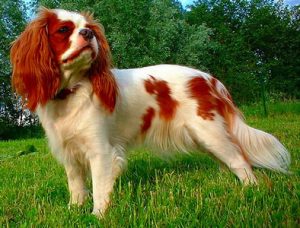
The Cavalier King Charles Spaniel is a small breed of dog of Spaniel type, considered one of the toy dog breeds. It is one of the most popular breeds in the United Kingdom and has become more popular in the United States over the last ten years. It is a smaller breed of spaniel, and adults are often the same size as adolescent dogs of other spaniel breeds. It has a silky coat and commonly an undocked tail. Four colours (Blenheim, Tricolour [black/white/tan], Black and Tan, and Ruby) are recognised by the breed standard. It is a friendly, affectionate breed which is good with both children and other animals.
The Cavalier shares the same history as the smaller King Charles Spaniel until the 1920s, at which time breeders attempted to recreate a spaniel resembling Charles II’s King Charles Spaniel of the Restoration. The King Charles had changed drastically in the late 1600s following interbreeding with flat nosed breeds, and the Cavalier is seen as a return to the type of spaniel before that interbreeding.
There are a few health issues that affect this particular breed, most notably mitral valve disease which leads to heart failure. This will appear in most Cavaliers at some point in their life and is the most common cause of death. Syringomyelia is also present which is a malformation of the skull, reducing the space available for the brain. They are also affected by ear problems which are common among spaniels of various types as well as issues such as hip dysplasia which are common across many types of dog breeds.
Colour
The breed has four recognised colours. Cavaliers which have rich chestnut markings on a pearly white background are known as Blenheim in honour of Blenheim Palace, where John Churchill, 1st Duke of Marlborough, raised the predecessors to the Cavalier breed in this particular colour. Black and Tan are dogs with black bodies with tan highlights, particularly eyebrows, cheeks, legs and beneath the tail. Black and Tan is referred to as “King Charles” in the King Charles/Toy Spaniel. Ruby Cavaliers should be entirely chestnut all over, although some can have some white in their coats. The fourth colour is known as Tricolour, which is black and white with tan markings on cheeks, inside ears, on eyebrows, inside legs, and on underside of tail. This colour is referred to as “Prince Charles” in the King Charles/Toy Spaniel.
Popularity
According to statistics released by The Kennel Club, Cavaliers were the 6th most popular dog in the United Kingdom in 2007 with 11,422 registrations in a single year. Labrador Retrievers were the most popular with 45,079 registrations in that year. Their popularity is on the rise in America; in 1998 they were the 56th most popular breed but in both 2007 and 2008 they were the 25th most popular. They ranked higher in some individual US cities in the 2008 statistics, being eighth in both Nashville and Minneapolis-St.Paul, seventh in Boston, Atlanta and Washington D.C., and sixth in both New York City and San Francisco.
In 2008, the Cavalier was the fourth most popular breed in Australia with 3,113 registrations behind only Labrador Retrievers, German Shepherd Dogs and Staffordshire Bull Terriers.
In addition, there are also national breed clubs in Belgium, Canada, Czech Republic, Denmark, Finland, France, Germany, Italy, Netherlands, New Zealand, Norway, South Africa and Sweden.
Temperament
The breed is highly affectionate, they are playful, extremely patient and eager to please. As such, dogs of the breed are good with children and other dogs. Cavaliers are not shy about socialising with much larger dogs. Cavaliers will adapt quickly to almost any environment, family, and location. Their ability to bond with larger and smaller dogs make them ideal in houses with more than one breed of dog as long as the other dog is trained. Cavaliers are great with people of all ages, from children to seniors, making them a very versatile dog. They rank 44th in Stanley Coren’s The Intelligence of Dogs, being of average working/obedience intelligence. Cavaliers are naturally curious and playful, but also enjoy simply cuddling up on a cushion or lap.
Cavaliers are active and sporting. They have an instinct to chase most things that move including while on busy streets, and so most Cavaliers will never become “street-wise”. As Cavaliers tend to regard all strangers as friends, they will also never make a good guard dog. Being a spaniel they have a strong hunting instinct, and therefore should be watched around birds and small animals. However, owners have reported that through training their Cavaliers live happily with various hamsters, gerbils and so on.
—————————————————————————————————————–
CARING FOR YOUR DOG NEWSLETTER – Delivered Directly To Your Inbox – Starting Immediately – SIGN UP FOR FREE TODAY
—————————————————————————————————————–
